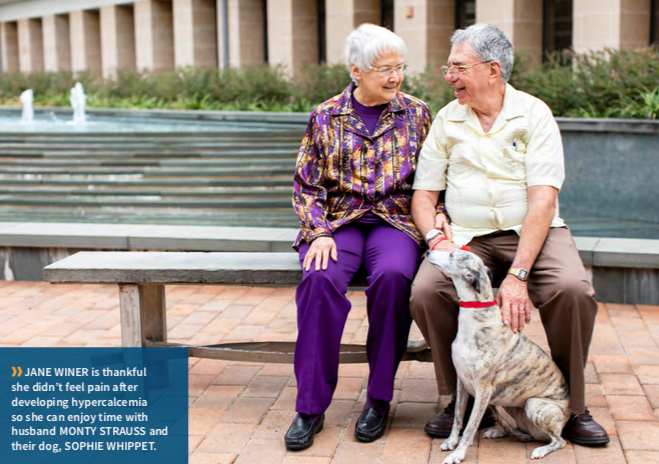Publication
Article
CURE
Strange Signs: Cancer-Related Paraneoplastic Syndromes
Author(s):
Cancer can trigger symptoms that seem as mysterious as their name: paraneoplastic syndromes.
In January 2019, Jane Winer was being treated for non-small cell lung cancer near her home in Dallas when she started experiencing seemingly unrelated symptoms. She felt weak and fatigued, had trouble moving her hands and fingers, and often found herself trembling.
Her oncologist at the University of Texas (UT) Southwestern Medical Center, Dr. David Gerber, took a blood test, and immediately after he got the results, he admitted Winer to the hospital. The diagnosis: hypercalcemia, or excess calcium in the blood, which can cause excessive fatigue, gastrointestinal symptoms, and, most notably, neurologic symptoms.
Hypercalcemia is one of numerous disorders known as paraneoplastic syndromes. These diseases can occur in patients with any kind of cancer, but they’re particularly prevalent in lung cancer, affecting an estimated 10% of patients being treated for the disease. Paraneoplastic syndromes can be brought on by one of two cancer-related phenomena: Either the tumors secrete proteins or other substances that trigger the syndromes or the immune system reacts to the cancer in a way that affects normal tissues and organs, like the brain and nerves.
“Even though these many different conditions that all fall under the category of paraneoplastic syndromes, they are really all different diseases,” says Gerber, professor of internal medicine and population and data sciences in the Harold C. Simmons Comprehensive Cancer Center at UT Southwestern.

In Winer’s case, hypercalcemia signaled that her initial lung cancer treatment, Tagrisso (osimertinib), was no longer working. She had been taking the drug, which targets tumors with EGFR mutations, for eight months. During her hospital stay, she was given fluids to flush the calcium out of her blood. To further lower her calcium levels, she also received medications including calcitonin and zoledronic acid, a bisphosphonate therapy that is also used to treat osteoporosis. Then she was switched to a chemotherapy regimen of Alimta (pemetrexed) and carboplatin. She’s now off the carboplatin and receives Alimta every three weeks.
Winer’s most recent imaging tests showed stable disease; the hypercalcemia is under control, too. “I feel better than I have since I was diagnosed,” says Winer, 71, the retired dean of the College of Arts and Sciences at Texas Tech University. “At one point I was sleeping 15 to 18 hours a day. Now I don’t feel fatigued at all.” Because her current chemo- therapy regimen is adequately controlling the cancer, she does not require additional treatment to prevent hypercalcemia.
Three of the four paraneoplastic syndromes most commonly in lung cancer are usually caused by tumor secretions, including hypercalcemia. About 80% of these cases occur when lung tumors produce parathyroid hormone-related protein, which impairs the kidneys’ ability to process calcium and phosphate. Hypercalcemia can also result from the cancer spreading to bone and prompting the release of calcium, though this is more common in other types of cancer.
Hypercalcemia can cause a range of symptoms, such as confusion, nausea, constipation, fatigue, weakness, dehydration, muscle pain and — in extreme cases — kidney failure. First-line treatment involves administering saline intravenously to flush out the excess calcium and treat dehydration, which can stress the kidneys.
For tough-to-treat cases of hypercalcemia, infusions of bisphosphonates such as Zometa (zoledronate) can be effective. By interfering with osteoclasts, the cells that degrade bone, these drugs lower calcium levels and are often given regularly afterward to prevent further episodes. Another option is Xgeva (denosumab), which also inhibits osteoclasts but can be more convenient because it is administered every four weeks as an injection under the skin rather than an IV infusion.
TREATING THE CANCER FIRST
Syndrome of inappropriate antidiuretic hormone secretion (SIADH) is another paraneoplastic disorder that’s linked to tumor-produced substances. An estimated 16% of patients with small cell lung cancer (SCLC) develop SIADH, which causes the body to retain water, resulting in an imbalance of water and sodium in the body and leading to low sodium levels in the blood. If unaddressed, initial symptoms of headache, weakness and confusion can progress to more serious complications, including seizures, respiratory distress and coma.
SIADH is often treated by temporarily restricting fluid intake and increasing dietary protein and salt. Demeclocycline, a medication that promotes elimination of water from the body through the kidneys, can also be used to raise sodium levels.
“Treating the cancer can improve or even get rid of the symptoms,” Gerber says, because hypercalcemia and SIADH are typically caused by the tumors. When a paraneoplastic syndrome emerges in a patient with lung cancer, it can be a sign that therapy has stopped working and needs to change, he adds.
Sometimes patients notice the signs of a paraneoplastic syndrome before they even know they have lung cancer. When patients report these symptoms to a primary care physician
or specialist such as a neurologist or an endocrinologist, those physicians might suggest an evaluation for lung cancer, particularly if the patient is a current or former smoker.
For example, Cushing’s syndrome occurs when tumors secrete substances that cause the adrenal glands to release the steroid hormone cortisol. Commonly known as the stress hormone, cortisol affects many important processes in the body, including metabolism, memory and blood pressure. Excess levels produce symptoms such as muscle weakness, swelling, hypertension and weight gain. Cushing’s occurs in up to 5% of patients with SCLC and is associated with other neuroendocrine lung tumors such as carcinoids.
When treating the primary tumor fails to relieve Cushing’s symptoms, patients can be given drugs such as ketoconazole that suppress cortisol production, as well as blood pressure treatments and diuretics.
EASING THE SIDE EFFECT BURDEN
Among the paraneoplastic syndromes that are caused by an immune reaction rather than tumor secretions, Lambert-Eaton myasthenic syndrome (LEMS) is most commonly seen in lung cancer. An estimated 3% of patients with SCLC also have LEMS, which causes muscle weakness and fatigue.
“The immune system is trying to attack the cancer, but at the same time, it attacks the nerve endings that go to the muscles,” says Dr. Mohammad Alsharabati, a neurologist in Des Moines, Iowa. The main symptom is muscle weakness, which can affect virtually any voluntary muscle, including in the eye, head and neck. “Some people have dizziness while standing up, dry mouth, double vision, (or) trouble swallowing, and often they lose their reflexes on neurological exam,” he says.
Treating LEMS in patients with cancer can be challenging. The muscle-strengthening drug guanidine is an option, but it can cause serious side effects like balance problems and stomach pain that can be especially problematic for patients already grappling with side effects of cancer treatments. Immunosuppressant medications can be effective, but they weaken the immune system and therefore are not a good choice for patients with cancer, Alsharabati says.
In November 2018, the Food and Drug Administration approved the first drug to treat LEMS, Firdapse (amifampridine), which improves signal transmission to the muscles by opening up blocked calcium channels. Alsharabati, who served as a clinical trial investigator for the drug, believes that for patients with lung cancer, Firdapse is safer than older treatments because the side effects seen in clinical trials, including limited tingling around the mouth and in the hands and feet, were mild.
Patients with lung cancer should first complete chemotherapy, if needed, and then undergo a more aggressive treatment for LEMS, Alsharabati says.
When patients with lung cancer develop paraneoplastic syndromes, their oncologists sometimes consult other specialists for advice on how best to proceed with treatment, says Dr. Michael Shafique, a thoracic oncologist at Moffitt Cancer Center in Tampa, Florida.
“Oftentimes, for SIADH, we’ll have a nephrologist help with the consultation,” Shafique says. “They can run additional urine tests, which can be helpful in managing the diagnosis and treatment.” For LEMS, neurologists have the most experience with medicines like (Firdapse), which can help patients who don’t respond to therapies aimed at eradicating the cancer, he adds. These specialists can also help diagnose many other uncommon neurological paraneoplastic syndromes that can present with unusual constellations of symptoms.
NO STUPID QUESTIONS
Several other paraneoplastic syndromes are rare but sometimes occur in patients with lung cancer. Some patients develop hypoglycemia, or low blood sugar, which causes symptoms such as confusion, sweating and anxiety. A number of neurologic syndromes, including peripheral neuropathy, a condition most commonly seen in SCLC, can cause pain or a loss of sensation in the hands.
Gerber urges any patient fighting lung cancer to speak up about symptoms that seem out of the ordinary. “There are no stupid questions or concerns. The emergence of any new symptom that wasn’t a problem in the past could be a paraneoplastic syndrome,” he says.
As Gerber instructed, Winer came to each of her appointments with a list of all her current symptoms. “It was quite a list: weakness and fatigue and trembling in my hands that made it hard to do email or write very well,” she recalls of the day she learned she had hypercalcemia.
When she saw the large bags of fluids to be hooked up and infused at high speed into her body to flush out the calcium, she was afraid the therapy would be painful. It wasn’t. “I’ve been very fortunate through this whole thing that I have not experienced pain,” Winer says. “I feel well. I appreciate that.”

2 Commerce Drive
Cranbury, NJ 08512
All rights reserved.




